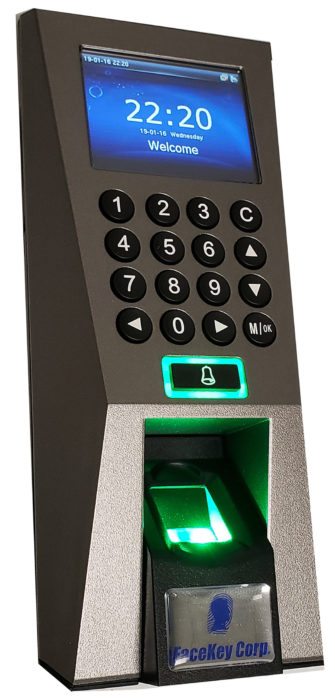 Why FaceKey Access Control Systems
Why FaceKey Access Control Systems
FaceKey has provided superior business security and access control solutions to customers across a wide range of industries for over two decades. Our access control systems are built on a server-client architecture that runs over IP networks, resulting in easy installation, simple operation, and minimal training requirements. Data collected at each door is automatically uploaded and configurations made at the network level (e.g., adding or deleting a user) can be distributed selectively to each door unit. Additionally, FaceKey uses face and fingerprint recognition, which guarantees the highest level of accuracy during recognition.
Compared to our card access systems competitors, FaceKey produces a practical, cost effective access control system that provides a level of accuracy that card access systems can never reach. Access cards can be stolen, lost or shared with others. In addition, card access systems require far more materials and labor to install. For identification, FaceKey access control products use the most powerful and accurate of credentials: your face and your fingerprints.
Why Use Access Control Systems?
The purpose of access control systems is to prevent access by unauthorized persons to protected information, property, equipment, and secure areas. Traditional access control systems included PINs, lock-and-key mechanisms and card readers. However, all come with an inherent security risk: PINs, keys and cards all depend on a credential which can be lost, stolen, or shared with others.
FaceKey’s access control systems utilize biometric – face and fingerprint – credentials, which is unique to the user and does not pose the security risk inherent in PINs, lock-and-key mechanisms, and card readers.
Well-designed security systems can significantly reduce the risk to a business or organization. aceKey access control systems which utilize biometric features as credentials for identification will always win because the credential will not fail and allow entry of unauthorized persons.
How Do FaceKey Access Control Systems Work?
FaceKey, like other electronic access control systems, consists of four main components: the reader, the access control panel which is embedded in the reader, the lock mechanism and the unique identification or credential element.
FaceKey Systems with multi-factor authentication (MFA) enabled can require two or more unique identification elements for added security. FaceKey access control systems use biometric features for unique identifiers which remedies the identification issues inherent in traditional access control systems.
Once your FaceKey electronic access control system is fully setup (i.e., installed and programmed), it works as follows:
- Enrollment of users: The faces and fingerprints of users are enrolled into the system, converted into a numerical code and stored in the encrypted database.
- Identification: The user presents their face or fingerprint to the reader for authentication.
- Verification: Upon receiving the users’ credentials, the access control reader/panel (1) verifies the user’s identity by matching the live face or fingerprints with the user’s data in the database; and (2) verifies that the user is allowed access to that specific door or access point.
- Authorization: Once the credentials are verified, the reader/control panel allows user access to the area or action permitted for the user’s name. For example, if the verified user is authorized to access the locked door at 8:00 AM, the door will automatically unlock at 8:00 AM.
- Recording: Each time a face and fingerprint is presented to the reader and the user is recognized, a searchable electronic record is made of the user’s name, the time, and the location of the reader.
To be effective, the system must be able to accurately grant entry to authorized users and reject entry of unauthorized persons. FaceKey systems succeed without fail.
FaceKey Access Control Systems Meet Criteria for all Three Categories
Access control systems can be classified into three main categories based on how they allow access permissions to be granted and who can set access permissions; (1) discretionary access control (DAC) systems, (2) role-based access control (RBAC) systems, and (3) mandatory access control (MAC) systems.
Discretionary Access Control Systems
Discretionary access control (DAC) allows the system owner or administrator to set the policies that determine which resources the user or entity can access. While DAC models are flexible and user-friendly, their lack of centralized control can be a disadvantage in some applications.
Role-Based Access Control Systems
Role-based access control (RBAC) is a non-discretionary access control model in which access rights are assigned according to defined business functions or roles—e.g., executives, accountants, engineers, etc.—as opposed to individual user accounts. This setup ensures that the user’s access is restricted to the specific areas or information required to perform their job.
Mandatory Access Control Systems
Mandatory access control (MAC) allows access rights to be defined and regulated by a central authority based on multiple security levels. This setup is extensively used by government organizations, militaries, and other high-level institutions that are responsible for protecting highly confidential information. Classification levels are assigned to system resources, and access is permitted or denied according to the user’s information security clearance.
Key Benefits of FaceKey Access Control Systems
- Simplified management: Access control systems allow easy management and monitoring of user access across multiple buildings, locations, or databases. With real-time event log monitoring, organizations can closely track a user’s activities to ensure employees are working at the appropriate locations or times. Knowing which employees had access to specific areas within certain timeframes is also critical when investigating thefts or other incidents.
- Improved access and productivity: By customizing access requirements for individual users, access control systems create a more flexible and productive working environment. Employees can enter the workspace according to their own schedule without having to wait for management to unlock doors. Access control systems also allow administrators to set specific access dates or times to accommodate visitors or special events.
- Increased safety and security: Access control systems facilitate a safer and more secure work environment by protecting against unwanted visitors and preventing data breaches. They help companies maintain compliance with strict industry regulations and security standards.
- Reduced accidents: By having the proper access control system in place, organizations can reduce the risk of employee accidents by making sure only trained or authorized users have access to designated areas.
- Optimized use of resources: Access control systems allow organizations to reduce expenses by eliminating the need for security guards. When integrated with the facility’s lighting and HVAC system, they can also limit energy consumption in unoccupied spaces. Similarly, they promote better space utilization by allowing organizations to open or close floors based on occupancy data and usage frequency.
- Keyless and touchfree entry: By providing keyless entry when using face and fingerprints based access control systems eliminate (1) the cost and hassle of having to replace keys, change locks when an employee loses a key, (2) no cards will be required, and (3) concerns about copied, stolen, lost and shared cards. Changing the type of entry will reduce administrative costs while increasing security.
- Touchfree entry: Face recognition permits an entry door to be touchfree. Safety of customers and employees is top priority for every organization. Surfaces such as door knobs are potential health hazards. Health experts recommend reducing common touch points to prevent the spread of illnesses. Safe Touch-Free Access Control System reduces the need to touch door knobs or doors, and potentially reduces infection and disease.
Applications for FaceKey Access Control Systems
FaceKey access control systems are used in industrial, commercial facilities ranging from mom and pop office to large corporations.
The crucial issue for security: Does the system require a credential that can without fail, refuse access to an unauthorized user? FaceKey provides failure proof access control with face and fingerprint recognition.
Examples of typical Access Control System applications include:
- Apartments: Access control systems enhance the safety of apartment complexes by securing entrances and tracking who exits and enters the property.
- Banks: In banking facilities, access control systems play a critical role in protecting personal customer information and maintaining compliance with the Gramm-Leach-Bliley Act. Controlling the gate to safety deposit box vaults is reducing costs without loss of identification of box owners and record keeping.
- Data centers: Access control systems protect computing and networking equipment from unauthorized access.
- Food processing plants: Food processing facilities use access control systems to increase personnel safety and reduce facility protection costs. FDA’s Food Safety Modernization Act is one of the basic rules required to maintain compliance with FDA food defense guidelines which aims to prevent tampering or intentional adulteration of the food supply. FaceKey access control meets the standards for physical control as required by the FSMA.
- Gaming sites: In gaming applications and casinos, access control systems are implemented to prevent theft and protect office operations involving large amounts of cash.
- Government facilities: Access control systems allow local and state governments to safeguard sensitive information and comply with homeland security regulations.
- Healthcare centers: In hospitals and other healthcare environments, access control systems prevent unauthorized access to confidential health records, medications, proprietary materials, and more.
- Manufacturing plants and construction sites: In manufacturing and construction settings, access control systems reduce theft and unauthorized site access while allowing employee attendance and activities to be more closely monitored.
- Schools and research institutes: In schools and research institutes, access control systems enhance student and employee safety while safeguarding confidential information.
- Worship centers: In worship centers, access control systems can be customized to secure offices, daycare centers, and other restricted areas while maintaining a welcoming and open environment.
- Dangerous equipment: Access can be restricted to dangerous or expensive equipment such as bobcats and CNC machinery. Access control when properly applied will reduce damage to equipment, injury and improve safety in the facility.
- Specialty doors: Opening an overhead door in a warehouse with a deep drop down would be hazardous if people or equipment exited without proper equipment. In warehouses, access control systems can be used to prevent such exit doors from being opened by unauthorized persons.
Superior Access Control Solutions from FaceKey
Looking for an access control solution you can trust in your secure facility?
FaceKey is the ideal partner! We offer a range of security products that use facial or fingerprint recognition technology for user identification. Our product solutions offer maximum protection and cost efficiency in an easy-to-operate package. Key features include three-factor identification, door sensor input, alarm output, and exit request. To learn more about it, schedule a free demo via Zoom today.
For additional questions or concerns about our biometric access control systems and how they can benefit your facility, contact us or request a quote today.
EntryGuard™ delivers maximum protection and cost efficiency.
The easy-to-operate EntryGuard system will provide your company with exceptional protection, versatility, accuracy and cost efficiency. This state-of-the-art access control system provides features including three factor identification, door sensor input, alarm output and exit request.
